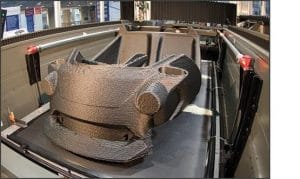The Future of the Automotive Industry - 3D Printing Takes the Wheel
Since the beginning, the automotive sector has been taking advantage of 3D printing for manufacturing and design applications. With a quick turn around rate, companies are able to produce concept models, functional prototypes, and manufacturing aids in a short amount of time. With this technology at hand, today’s technologies have drastically improved from the idea of a prototype to the full production of 3D printed vehicles like the Local Motors Strati concept car.
Automotive industries are seeing the positive effects of using additive  manufacturing. Paul Susalla, the section supervisor of Rapid Manufacturing at Ford stated, “You can come up with a really optimized part at the end of the day…That’s all because of the speed with which we can produce the prototype parts without tooling.” Not only are 3D printed prototypes great for a fast turnaround, but statistics are being proven with numbers.
manufacturing. Paul Susalla, the section supervisor of Rapid Manufacturing at Ford stated, “You can come up with a really optimized part at the end of the day…That’s all because of the speed with which we can produce the prototype parts without tooling.” Not only are 3D printed prototypes great for a fast turnaround, but statistics are being proven with numbers.
The proof
In 2015, a study conducted by Statistics MRC showed that the automotive 3D printing market had reached roughly $520 million in 3D printing growth. These numbers showed no signs of slowing down as there is expected to be $2.5 billion in growth by year 2022. While 3D printing has not yet expanded to full-scale production mass produced parts, the adoption of technology is booming in automotive.
Companies such as Minimizer, a producer of semi-truck components, are using 3D printing not only for prototyping, but for aftermarket components that are being used on the vehicles themselves.
More material options
As stronger and more durable materials such as nylon, ultem, and carbon fiber become more readily available, automotive manufacturers have more options for utilizing 3D printing for applications that have restrictions of heat or wear concerns.
For those on the automotive assembly line, many different fixtures and gauges are seen in production. Most of these products would traditionally be made out of metal, but can now be made in a durable yet light plastic or photopolymers to bring the parts to life. The benefits of this change in production means a reduce in cost for the production, and also less worker fatigue – a win all around.
Pedal to the metal
The expansion of metal 3D printing technology has the automotive industry excited as well. Although the technology is a bit more expensive and not as mature as Fused Deposition Modeling (FDM) and Polyjet, the ability to print in metal is extremely intriguing for parts that are high in complexity, low in volume, and require to be metal by nature.
 Bringing 3D printing into the automotive manufacturing landscape is soon becoming a necessity for keeping up with the competition rather than a complementary technology, especially in the production of cars.
Bringing 3D printing into the automotive manufacturing landscape is soon becoming a necessity for keeping up with the competition rather than a complementary technology, especially in the production of cars.
Major 3D printing companies such as Stratasys, GE, and 3D Systems are only continuing to improve their technology, and the cost for implementing it into everyday workflow will continue to come down. Conversely, with the advancements in technology and build speeds, the users of 3D printing will see parts that are of high quality in the materials needed to keep automotive production driving forward.

 Blog
Blog